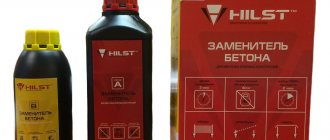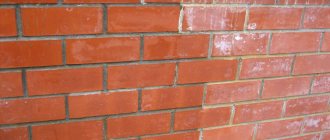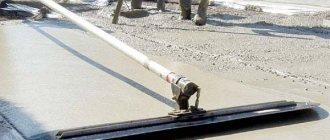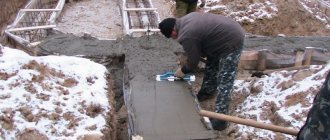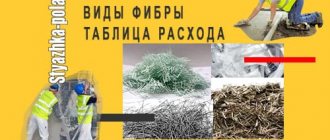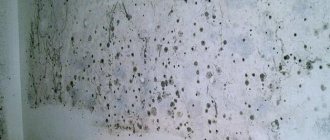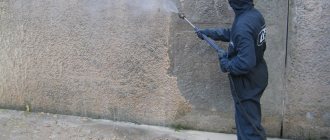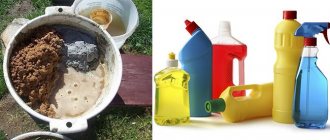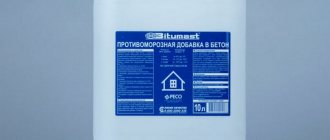Upon completion of construction work, a concrete cleaner will help clean the work equipment and the area of the structure being constructed from any remaining cement mortar. These are special chemical compositions containing solvents that allow you to quickly and effectively remove hardened material from various surfaces. The pricing policy for such drugs depends on the brand and manufacturer; many builders prefer to use homemade products.
Cement wash problem
Cement that has not set after masonry or plastering work can be cleaned off with a damp rag or spatula. This is the easiest and most substrate-safe stain removal method.
Whether it’s new plastering or removing the old layer - if the concrete has set, it eats firmly into the base, then removing the material becomes problematic. In such cases, there are several ways to remove cement stains:
- Mechanical removal with a spatula, chisel and hammer, or grinder at low speed. This is a surefire way, but it is dangerous due to damage to the cladding;
- Trying to use available household chemicals or food products (citric acid, toilet cleaner). The use of products with an aggressive environment does not always help; there is a risk of damage to the facing layer;
- Cleaning concrete with special substances (solvents).
Professionals know about concrete cleaners and actively use them in their work, which cannot be said about ordinary people. Let's fill the lack of information.
What surfaces can concrete be removed from?
Special concrete removers are compatible with many materials: from plastic and glass to brick and metal. To make sure that the product can be guaranteed to be used on a particular coating, carefully read the instructions. The specifics of using the solvent will be indicated there.
In addition to removing cement stains and splashes from walls, floors, and ceilings, concrete cleaning products can be used to:
- tools;
- equipment;
- double glazed windows;
- textiles
Cleaning concrete mixers
Concrete mixers are used to mix mixtures, so they need to be cleaned at the end of work. This applies not only to small household models used in homes or in the country, but also to machines that supply concrete to a construction site.
Cleaning the concrete mixer should begin from the outside. First, large lumps are removed with a shovel or spatula. Then a solvent is sprayed onto the surface, left for the required time and washed off. If we are talking about special equipment, make sure that the composition does not get on the engine. To do this, cover it with film and do not direct the wash stream there.
Brick walls
A mortar remover can help remove the old layer of cement from brick walls. This method is more gentle than hammering the surface. In addition, the noise level will remain within normal limits, so you will not disturb your neighbors early in the morning or in the evenings.
An important nuance: sand-lime bricks cannot be treated with solvent. They have a porous structure, through which acid gets inside and destroys the masonry. But red ceramic brick can be subjected to such influences. The main thing is not to overdo it.
Treating walls is very simple: apply the product and wait the right time. Then you can remove cement and concrete using a brush, spatula, or trowel. Then you need to rinse everything thoroughly with water to deactivate the solvent so that it does not damage the masonry.
Double-glazed windows
Windows covered with cement splashes are a common situation after renovation. Everything is complicated by the fact that a spatula or chisel cannot be used. They can scratch glass and plastic. Therefore, it is recommended to use special equipment. The sequence of actions is as follows:
- Spray the remover onto the glass and leave for 20-30 minutes.
- Gently, without pressing, remove the softened mixture with a cloth.
- Treat the surface with window cleaner to remove streaks.
Composition and principle of action of solvents
Cement solvent is an active liquid containing acid, inhibitors and other active substances. After application, the drug destroys the cement structure by an active oxidation reaction and gradually penetrates into the concrete drops or layers to be removed. The material softens, turns into pulp and is easily cleaned off with a spatula and rags.
The cement cleaner is suitable for any surface, including metal - the solution contains additives that prevent the oxidation of steel products. The solution does not deform tiles and wood if used according to the instructions.
The products are sold mainly in the form of concentrates, which need to be diluted with water to a working condition.
Mechanism of action: how do they work?
Modern industry offers the consumer a wide range of construction products for concrete removal. The differences between the drugs are hidden in the types of brands, manufacturers and components, but the mechanism of action of the drugs is determined by the same characteristics, namely:
Such products can be used even indoors, since they are completely odorless.
- No specific odor or toxic substances in the composition. That is why organic-based solvents are used for indoor work.
- Prevention of corrosion development.
- Can be used for decorative coatings, since the cleaners do not damage wood, high-quality plastic, ceramic tiles and metals.
- Destruction of the structure of a frozen material without damaging the original plane.
- Protection of products from destruction and deformation with the help of active substances and modifiers.
Areas of use
Cement mortars of plaster or concrete have a high degree of adhesion to all porous surfaces:
- To the brick;
- To the tile;
- To wood;
- To the concrete base;
- To the metal.
It is necessary to remove the stone in different cases:
- Remains of cement spray from the floor after plastering walls and ceilings;
- The solution is used to clean formwork after installing foundations;
- Acids can be used to clean tools after plastering, laying bricks and blocks;
- Old plastered surfaces that could not be removed mechanically.
In addition to concrete and cement stains, solvents can be used to remove lime and cement efflorescence from walls without leaving marks or relapses.
Cost of concrete cleaning products
Estimated cost of chemicals used for chemical cleaning of concrete surfaces:
| Name | Purpose | Cost, rub/liter |
| Himfrez Complex | Two in one. Dissolves laitance, opens pores and adhesively activates the surface. | 180 |
| Himfrez Cleaner | Removes cement film and opens concrete pores. | 140 |
| Himfrez Activator | Increases adhesion (adhesion strength) of concrete with cement and polymer coatings. | 140 |
| Mepta HimFrez | Cleaning concrete from cement film, efflorescence, plaque, etc., as well as improving adhesion. | 100 |
| Tiprom Plus | Cleaning facades made of brick, artificial and natural stone from salt deposits, cement mortar residues, and atmospheric pollution. | 90 |
Characteristics of solvents for concrete
Concrete stain removers are different, but have common characteristics:
- Solvents for concrete are non-toxic - they do not emit harmful fumes, and you can work with them indoors;
- Acid solutions are not flammable;
- The products do not damage the decorative coating of tiles and wood;
- The solutions do not smell;
- When working with acid concentrates, it is necessary to use personal protective equipment (gloves, overalls).
What cement cleaners are available in stores?
Chemicals for concrete removal are available in a wide range. For clarity, we present an overview of the most popular solutions in the table:
| Cleaner brand | Consumption | Compound | Packaging | Purpose | Price |
| Lugato saubere sache zementschleier entferner ("Lugato") | 30-100 g/m2 (according to degree of contamination) | Amidosulfonic acid | Canister 1 and 5 kg | Cleaning ceramic and glazed products, concrete | 500-530 rub./l |
| Divinol betonloser | Depending on the concentration (needs to be diluted) | Inorganic acids + corrosion inhibitors | Canisters of 25 and 200 liters | For concrete surfaces, metal, formwork of reinforced concrete forms, tanks, removing chalk stains | 290-50 rub./l |
| "Lepta Himfrez" | 1 liter per 3–4 m2 surface | Complex acids + surfactants | Canisters 5, 10 l | Brick, concrete, stone, tile. | 9-120 rub./l |
| EK 100 super | Depending on the concentration (needs to be diluted) | Mineral acids and inhibitors | Canister 10 liters | Removes all types of calcium stains, urinary stone, rust | 660-750 rub./l |
| Bio Decap'Beton Guard (eco-product) | 5–8 m2/l | water-based with particularly fine organic molecules | Canisters 5, 25 l | Cleaning tools: construction mixer, spatulas, shovels, etc., as well as all types of surfaces, including wood | About 2000 rub./kg |
| Barracuda 10K | About 10 m2/l | Synthetic product, does not require neutralization of the environment | Canisters of 1, 10 l or barrels of 200 l | Removing efflorescence and concrete stains | 600–700 rub./l |
How to clean concrete? When there is a need for a substance that can break down the cement layer, it is necessary to select the drug taking into account various factors:
- Thickness of the removed layer;
- Type of base coating - for example, plastics and polymers melt under an acid solution;
- Consumption and price - choose the optimal combination.
The price does not always correspond to the quality of the product, but in the case of solvents this rule works flawlessly. For example, the use of EK 100 or Barracuda 10K gives a guaranteed result, while the more democratic composition of Lepta Himfrez causes controversy among consumers and is suitable primarily for cleaning simple efflorescence, which it copes with excellently.
Ready-made products: well-known manufacturers
| Brand | Mechanism of action | Areas of application (processing) |
| Barracuda 10K | "Barracuda" does not have a specific smell | Swimming pools |
| Removes hardened material | Facades | |
| Not dangerous for tactile contact | Glass surfaces | |
| Loyal to glass and chrome | Construction equipment | |
| Divinol Betonloser | Removes hardened material | Concrete mixers and mixers |
| Breaks down rust and lime | Transport transporting solution | |
| "Bio Decap Concrete Guard" | Removes old material | Hardened concrete masses on any surface |
| Prevents corrosion of reinforced structures | ||
| "EK 100 Super" | Eliminates laitance | Wood, rubber, plastic |
| Marble and polymers | ||
| Liquid Monster Cement Remover | Effective control of old and new material | Processing any plane |
Solvent preparation
Concentrate products must be diluted with water in proportion. In this case, you must act in accordance with the instructions:
- For cement up to 28 days, the concentration can be 1:10 (medium:water);
- To remove efflorescence and small pockets of set stone – 1:3;
- For thick layers of cement – 1:1.
These are average proportions; you can select a suitable combination only according to the instructions for the drug.
A metal or enamel bucket is best for preparing the solution. Pour a measured amount of concentrate into it and add water, mix.
Destruction of reinforced concrete
To violate the integrity of the structure, crowns, drills and diamond-coated discs are used. When a large area is being dismantled, the reinforced material is destroyed using expensive equipment such as a wire rope machine. It is equipped with a diamond wire, which does the cutting. In most cases, this technique is used when it is necessary to dismantle a concrete structure whose thickness is about 1 m.
It is not recommended to break reinforced concrete yourself, because... Due to the high strength of the material, the chances of injury during dismantling increase. This work should be entrusted to specialists.
How to remove dried cement mixture
It’s easy to dissolve cement with your own hands using special solutions:
- Tools or small products can be placed in a container with active liquid and left until dissolved for a few minutes according to the instructions, then remove the softened cement from them and rinse with water;
- To clean a flat surface, the solvent is applied to a rag, which is applied to the stain. If it is large, the solvent is poured onto the area to be cleaned and covered with a cloth for several minutes. After time, the pulp is removed mechanically.
Home remedies: DIY
A homemade product can be prepared using sulfuric acid.
Store-bought chemicals are very convenient and effective, but there is a homemade cleanser option. You can remove dried mortar at home using the following means:
- Sulfuric acid. A solution is prepared in the proportion of 1 part of the active substance to 10 parts of water.
- Stain remover. Removes material residues from textiles.
- Vinegar, acetone, pure alcohol. A sponge is moistened in a solution of the selected substance, applied to the contaminated area and covered tightly with polyethylene for 1 hour to effectively remove the hardened solution from the fabric.
Security measures
Before using the product, it is recommended to test the resistance of the base. To do this, a small amount of the solution is applied to the surface in an invisible place and the reaction is observed.
During work, hands and body must be protected from acid contact with the skin and mucous membranes. Although the solutions do not emit odors (and some smell very strongly, it all depends on the composition), they are all equally harmful to the skin and can cause burns. You need to wear gloves when working, and for products with odors, use a respirator and ventilate the room well.
If the compounds come into contact with your skin, be sure to rinse it with running water or immediately neutralize it with baking soda.
Application: how to use chemicals correctly?
Before use, you need to read the instructions in detail, because each composition has separate specifics of operation and application. If the construction product requires it, dilute the material according to the scheme proposed in the information insert, although experts recommend buying a ready-made concentrate. Technical nuances of a properly carried out cleaning procedure:
After the specified time, the applied product is washed off with water.
- Prepare the site, remove debris, get rid of dust and dirt.
- If possible, remove large hardened elements mechanically.
- Apply the cleaner to the surface with a brush or roller.
- Wait 20-30 minutes. until the product forms a thick foam.
- Rinse off the foamy substance with water. If necessary, repeat the procedure.
Reducing the concrete layer
To reduce the layer, you can use a chemical concrete destroyer. But this method is suitable only in situations where the smoothness of the surface does not matter.
If it is necessary to reduce the thickness of, for example, screeds on the floor of a house, then the use of acidic mixtures can lead to uneven dissolution of the building material. There may be holes in the floor.
To reduce the thickness, it is recommended to use a grinding machine with special discs placed on it. When using this technique, the surface should be wetted. Water will reduce the temperature that occurs as a result of friction and will also reduce the amount of dust generated.
What does the solvent number mean?
Some formulations of multicomponent mixtures of volatile organic liquids have gained popularity as universal solvents due to their successful combination of characteristics. They are recorded in the regulatory and technical documentation and recommended for use. The most well-known compositions are standardized by a special standard GOST 18188-2020, which recently replaced a similar document from 1972. Conventional numbers are used to designate individual recipes.
Solvent grade 646. According to the definition of the standard, its purpose is to dilute nitrocellulose paints and varnishes (LKM), as well as other types of paints and enamels. It includes:
- toluene – 50%;
- ethanol – 15%;
- butanol – 10%;
- butyl acetate – 10%;
- ethyl cellosolve – 8%;
- acetone – 7%.
In practice, efficiency has been established when working with a wide range of film-forming coatings: nitrocellulose NC; alkyd PF and GF; melamido-alkyd MLs; epoxy EP; oil MA and a number of others. It is characterized by solvating activity above the average level. Aggressive towards a number of polymers, therefore not suitable for degreasing plastics. Vapors are toxic if inhaled for a long time and can cause changes in the state of consciousness and swelling of the respiratory tract. Due to large production volumes and popularity, it is relatively inexpensive.
Solvent grade 647. According to GOST, its purpose is to dilute nitrocellulose and other types of coatings when painting passenger cars. In practice, it is in demand for working not only with NC paints, but also with PF, GF and ML alkyds, polyurethane UR, urea MP, perchlorovinyl CV and some others.
Its composition:
- butyl acetate – 29.8%;
- ethyl acetate – 21.2%;
- butanol – 7.7%;
- toluene – 41.3%.
There is no acetone in the recipe, so this solvent has lower activity towards polymers. It can be used for degreasing and preparing plastic parts for painting. It is also used to restore the shine of previously applied layers of paint, since when wiped, the material dissolves the thinnest top layer of coating, which fills microcracks and traces of weathering, creating a gloss effect.
Solvent grade R-4. It contains only the three most common volatile organic liquids - an aromatic hydrocarbon, a ketone and an ester:
- toluene – 62%;
- acetone – 26%;
- butyl acetate – 12%.
Their combination is active against almost all film-forming resins from which polycondensation paints available in everyday life are made: PF, GF, ML, MC, AU, UR, KO, FL, NC, EP. It is also used as a diluent for polymerization paints and varnishes of the brands XB, XC, AC and others. Increased volatility ensures rapid drying, but also determines the fire hazard and toxicity of vapors.
“Home” methods for cleaning dried concrete mortar from surfaces
But besides the chemical method of cleaning concrete from surfaces, there are also “home” secrets and tricks for cleaning dried cement mortars.
Mechanical method
You can get rid of cement using a hammer, chisel, spatula and sandpaper. These tools and equipment can be used to clean ceramic tiles for reuse.
It is recommended to soak the tiles in water first: it will soften the cement and you can get rid of it with a spatula. You can clean glass in the same way.
Chemical method
Difference between solvents and thinners
In everyday understanding, these terms are often considered synonyms. However, solvents, unlike thinners, due to their chemical composition can react with other substances, affecting their structure to dissolve film-forming components. This allows you to change the consistency of thickened paints and varnishes, returning them to a “working” state.
Thinners cannot convert the curing components, but they can reduce the viscosity and change the consistency of the dye. All these substances have a high volatility rate, are flammable and have a strong characteristic odor.
Removing contamination
What people are willing to do to get rid of contaminants that interfere with their work. For example, when removing hardened cement, they use both nails and a hammer, trying to use these objects to destroy the hardened pieces and still tear them off the surface. Yes, this method may be effective, but it is only suitable if the surface itself does not have any value and there is no danger of damaging it. But what to do if the surface needs to be preserved and cannot be damaged in any way?
Pollution removal scheme.
For example, there are times when, after removing old tiles from a wall, we want to use them again and put them, for example, in a garage or other place. But before using the tile again, it must be cleaned of cement. In such cases (to clean the tiles), builders advise immersing the tiles in water, covering all the cement on it with water. When the cement has softened a little, you can try scraping it off with a chisel. At this moment, the correct placement of the tile is important: it must be held in a horizontal direction, pressed firmly against a flat surface.
A cleaner used instead of water can speed up the softening process. Using a cleaner will remove cement from the tiles within half an hour.
Many people use a grinder to scrape off surfaces. In this case, it is recommended to set the tool to the lowest speed, first firmly fixing the material that will be cleaned.
Cleaning cement from windows
What to avoid when cleaning windows?
Do not use too hot water - it reduces the effectiveness of detergents. Use warm water with a maximum temperature of 30 °C (it is best to dilute it in a bucket).
Special cleaners and solvents
Important! This method is also suitable for cleaning other interior and exterior items, for example, stairs, fences, garden tools (yes, it also often becomes a “victim” of cement mortar).
Cleaning with soda and vinegar
Lemon juice cleansing
Cement stains from windows also with lemon juice:
Kawabanga! Which polymer paint for concrete is better for exterior use?
Cleaning with water
Representatives of ester solvent types
These include:
- Methyl acetate type of solvent is a quickly evaporating substance.
- Ethyl acetate is characterized by a pleasant odor, rapid volatility and low boiling rate. The solvent has a yellowish tint, rapid volatility and is therefore used when increasing the time interval for complete drying of paints and varnishes.
- Amyl acetates have similar characteristics to butyl acetate, have a distinctive odor, and evaporate slowly.
- Acetone is one of the most toxic types of solvents with a heavy odor, high volatility and flammability.
- A mixture of soluble substances is used to dilute nitro enamels to the desired thickness. They contain esters of complex structure. The quality of the painted layer is affected by the composition of the solvent. In particular, if you add more chemicals to the paint than necessary, the coating will become cloudy. By adding a substance with long volatility, the painted layer will become smooth and attractive in appearance.
- Acrylic solvent is similar to a white liquid with a specific odor, is made on the basis of acrylic and is produced in several versions. Their use largely depends on the type of surfaces being painted, weather conditions and other factors.
- Glue solvent. Sometimes it is necessary to dilute the glue to a more liquid consistency or completely remove it from the surfaces. Some of the best are xylene, acetone or mixtures based on ethyl acetate.
How to clean concrete from dirt?
Take a broom with hard bristles, preferably plastic. And sweep your concrete
from particles of large debris.
Use a garden hose and water the surface of the concrete
to remove any
dirt
. The pressure created by the garden hose will be quite enough to remove major contaminants.
Interesting materials:
What is the difference between pine needles and cedar needles? What is the difference between Cypress and Cypress? What is the difference between an oxygen hose and a propane hose? What is the difference between a class and a brand? How does tuberous begonia differ from regular begonia? What is the difference between a column fan and a floor fan? What is the difference between split oak and sawn oak? What is the difference between commercial linoleum and household linoleum? What is the difference between commercial linoleum and regular linoleum? What is the difference between a passive indoor antenna and an active one?
Features and Specifications
Solvents are rapidly evaporating organic mixtures capable of dissolving thick substances, forming a solution of homogeneous composition.
The main purpose of the organic mixture is to dilute varnishes and paints to the desired thickness before applying to the surface to be painted.
The following requirements apply to solvents:
- Lack of reaction after applying paint to the surface;
- They should not lose hygroscopicity, that is, interaction with water should not lead to a loss of quality characteristics;
- The process of adding solvent to paint is recommended to be done without much effort, ensuring a homogeneous mixture is obtained.
The influence of the solvent on the paint occurs at the very beginning of its application to the surface to be painted. After a short period of time, it evaporates.
Each type of paint requires a certain category of solvent. With the right choice of chemical, the paint becomes uniform and easy to apply.
There are organic and inorganic types of solvents:
Organic types are divided into:
- Easily evaporated;
- Medium-volatile;
- Solidly volatile.
Easily evaporated substances include gasoline, solvent, and white spirit. They are used for diluting oil or acrylic paints, varnishes and enamels to a certain thickness.
- The listed solvents are flammable materials. It is recommended to carry out painting work away from fire.
- Kerosene is a medium-volatile substance. It is often added to dilute oil- or acrylic-based paints.
- A representative of a low-volatile soluble substance is turpentine. It has a specific smell and high density.
- The mixture can also be used to bring varnishes, some types of enamels and oil-based paints to a uniform consistency.
A significant disadvantage of organic mixtures is the strong suffocating odor. Therefore, you must wear a respirator to avoid poisoning.
There are paints that can be diluted with water. But this method is not suitable in regions with harsh weather conditions. At low temperatures, such coatings begin to crack.
